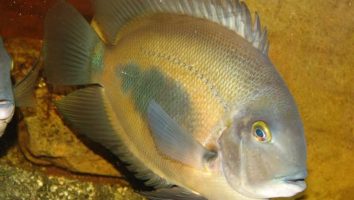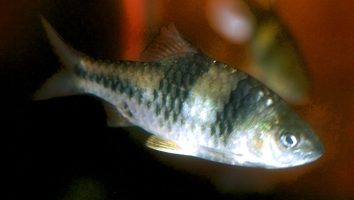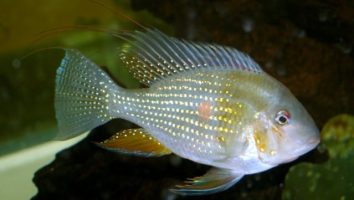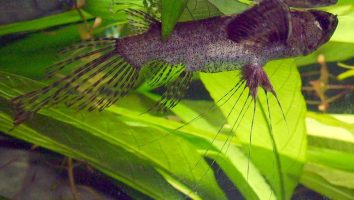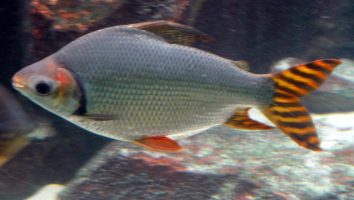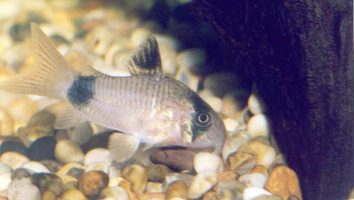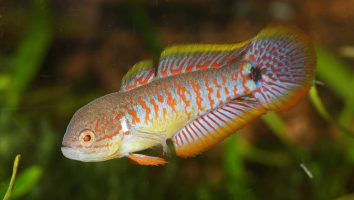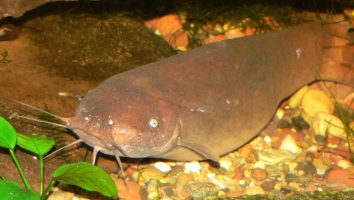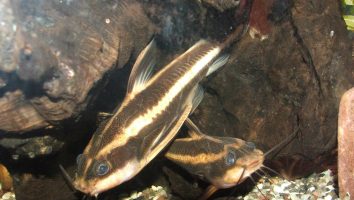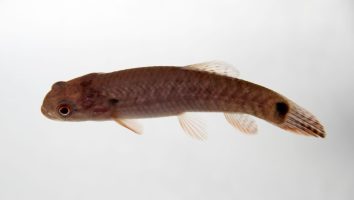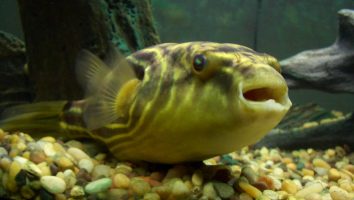The kenyi cichlid is a beautiful freshwater fish that is relatively easy to care for.
This species is native to Lake Malawi in Africa, and is a popular choice for many aquarium hobbyists.
Despite their peaceful nature, kenyi cichlids can be aggressive towards other fish that are similar in size and appearance.
It’s important to do your research before adding this fish to your tank, as they may not be compatible with your other fish.
In this guide, we’ll teach you everything you need to know about kenyi cichlid care. You’ll learn about their diet, tank mates, lifespan, and more!
Table of contents
Species overview
The Kenyi cichlid (scientific name: Pseudotropheus lombardoi) is a freshwater fish that’s native to Lake Malawi in East Africa.
They are one of the smaller cichlid species, only growing to be about 4 inches long at most.
In the wild, Kenyi cichlids live in groups of 20-30 fish. These groups are known as harems, with one male being dominant over the females.
The main draw of the Kenyi cichlid is its bright blue and yellow coloration. This makes it a popular choice for many freshwater aquariums.
Appearance
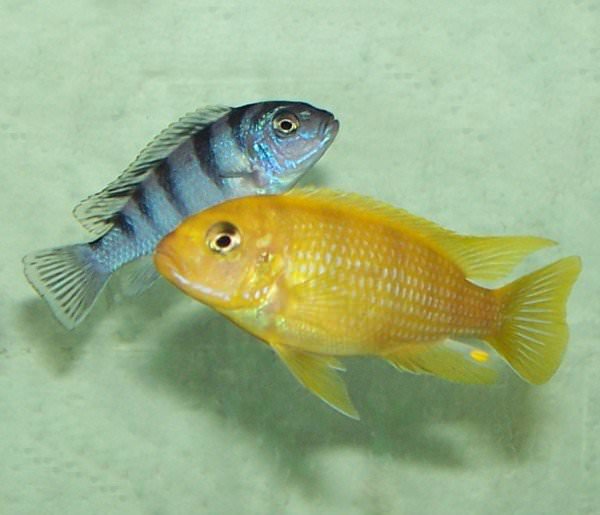
The Kenyi cichlid is a brightly colored freshwater fish that is popular in the aquarium trade. They are easily recognizable by their bright orange coloration with electric blue spots.
The body of the Kenyi cichlid is long and oval shaped. They have a long dorsal fin that starts about two-thirds of the way back on their body. This fin is tall and extends all the way to the back of the fish.
Their anal fin is similar in size and shape to their dorsal fin. Both of these fins have a long electric blue stripe running down the center.
The caudal fin of the Kenyi cichlid is forked and symmetrical. The base of the caudal peduncle is also orange like the rest of their body.
The Kenyi cichlid has a large mouth that extends past their eyes. They have large teeth that they use to eat their food.
The Kenyi cichlid is a peaceful fish that is good for beginners. They are easy to care for and make a great addition to any aquarium.
Lifespan
The Kenyi cichlid lifespan is typically between 10 and 15 years. As with most fish, their life expectancy is largely determined by the quality of care they receive.
If you provide them with a good diet, a clean tank, and appropriate tank mates then they should be able to live a full and healthy life. However, if any of these factors are lacking then their lifespan will be significantly shortened.
Size
The Kenyi cichlid can grow to be anywhere from 4 to 6 inches in length. Males are typically larger than females, and they may also have more coloration.
Tank
Tank Size
The recommended minimum tank size for Kenyi cichlids is 50 gallons. This is assuming you’re keeping them in a school of at least 5 or 6 fish (which you should).
We personally recommend a slightly larger tank if you can accommodate it. Every extra space will make a big difference and allow you to keep a larger school or more tank mates if you’re interested in a community tank.
Water Parameters
The Kenyi cichlid is a peaceful creature that will do well in almost any freshwater aquarium. They prefer warm water with a neutral to slightly alkaline pH, but as long as the water is clean and well-oxygenated, they will be fine.
One of the most important things to remember when keeping Kenyi cichlids is to provide them with plenty of hiding places. These fish are very shy and will do best if they have plenty of places to hide.
Other than that, Kenyi cichlids are not particularly demanding when it comes to water parameters. As long as the water is clean and the pH is within the neutral to slightly alkaline range, they will be fine.
Here are a few basic water parameters to help create a healthy Kenyi cichlid environment.
- Water temperature: 72 to 82 degrees Fahrenheit
- pH levels: 7.0 to 8.5
- Water hardness: 5 to 15 dGH
- Alkalinity Levels: 5-15 dKH
What To Put In Their Tank
Kenyi cichlids are one of the more popular freshwater fish among aquarists. They’re known for being relatively peaceful (for a cichlid), hardy, and easy to care for.
When it comes to setting up the interior of their tank there are a few things you’ll want to keep in mind.
First, these fish love to dig. They’ll constantly be sifting through the substrate looking for food. This can uproot plants and disturb any decorations you have in the tank.
We recommend using a soft substrate like sand to help alleviate this problem. It’s also a good idea to go with rocks and driftwood instead of plants.
Second, Kenyi cichlids are known to be jumpers. They’re not the best swimmers so they’ll often try and launch themselves out of the water if they feel threatened.
To prevent this, make sure you have a tight fitting lid on your aquarium. We also recommend using taller plants near the surface to help block their line of sight (and give them something to hide behind if needed).
Last, these fish are social creatures. They do best in groups of 4 or more. If you’re only planning on keeping a few then we recommend a larger tank (75 gallons or more).
Common Diseases
Kenyi cichlids are a hardy fish, but that doesn’t mean they can’t get sick. The most common disease that affects this species is ich.
Ich is a very common freshwater disease that manifests itself as white spots on the body of the fish. It’s caused by a parasite that is often present in tanks with poor water quality.
If you notice your fish starting to get these white spots, it’s important to take action immediately. The longer you wait, the more severe the disease will become and the harder it will be to treat.
There are plenty of other potential diseases that can affect Kenyi cichlids, but they’re not as common. Some other things to look out for include infections, parasites, and hole-in-the-head disease.
As always, the best way to prevent these fish from getting sick is to maintain the quality of the water in their tank. A tank with clean and stable water conditions always leads to healthier fish who are more resistant to disease.
Behavior & Temperament
Kenyi cichlids are one of the most popular freshwater fish for aquariums. They’re known for their beautiful colors, easy care, and peaceful demeanor.
Kenyi cichlids are relatively small, only growing to be about 4 inches long. Even though they’re small, they have a lot of personality. They’re active and playful, but they’re also very peaceful.
These fish are perfect for beginners because they’re easy to care for and don’t need a lot of attention. They’re also perfect for community tanks because they get along with other fish. The only thing you need to be careful of is putting them in a tank with fish that are too small. Kenyi cichlids are known to eat smaller fish!
All in all, Kenyi cichlids are a great choice for any aquarist. They’re beautiful, easy to care for, and peaceful.
Tank Mates
Kenyi cichlids are one of the more aggressive species on this list. They’re not the most aggressive, but they’re up there. As a result, their tank mates need to be carefully chosen.
The first step is to find fish that can handle similar water conditions. These cichlids come from Central and South America where the water is fairly warm and soft.
The next step is to find fish that can hold their own. Kenyi cichlids will likely try to establish dominance in the tank. They’re not typically successful in taking on larger fish, but they can bully smaller ones.
With those factors in mind, here are some possible tank mates for Kenyi cichlids:
- Convict Cichlid
- Firemouth Cichlid
- Jaguar Cichlid
- Oscar Cichlid
- Texas Cichlid
- Green Terror Cichlid
- Red Devil Cichlid
Breeding
The Kenyi cichlid is a beautiful fish that’s popular in the aquarium trade. They’re not the easiest fish to breed, but it can be done with some patience and effort.
To start, you need to set up a breeding tank. It should be at least 40 gallons in size and have a sand substrate. Be sure to add some rocks and hiding places for the fish.
Next, you need to adjust the water conditions. The pH should be between 7.5 and 8.5, and the water hardness should be 10-20 dGH. The water temperature should be between 78 and 82 degrees Fahrenheit.
When everything is in place, add two males and four females to the tank. The males will be the larger of the two, and they’ll have more coloration.
The next step is to wait and see if the fish start to spawn. If everything goes according to plan, the females will lay their eggs on a flat surface like a rock. The males will then fertilize them.
Once the eggs have been fertilized, the males will guard them diligently. After about a week, the eggs will hatch. At that point, you can start to feed the fry live foods like brine shrimp or bloodworms.
As the fry grow, you can start to introduce them to pellets and flakes. When they’re big enough, you can move them to a larger tank.
Conclusion
The Kenyi cichlid is a beautiful fish that is relatively easy to care for. They are a great addition to any freshwater tank and will add some color and personality.
While they are not the most aggressive cichlids, they can be territorial so it is important to provide them with plenty of hiding places.
Overall, the Kenyi cichlid is a great choice for most aquarium enthusiasts.

